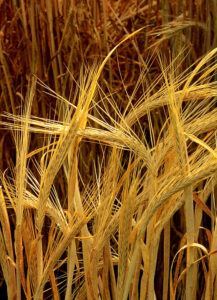Grains and Bread in Abundance
 Barley loaves, the gift of the man from Baal-Shalishah to the prophet Elisha and the gift of a child to Jesus, share the spotlight in the readings for the Seventeenth Sunday of Ordinary Time. Both the first reading from the second book of Kings (2 Kings 4:42-44) and the gospel reading from St. John (Jn 6:1-15) feature a person who brings a gift of food to the prophet. The prophet receives the food and instructs that it be shared among the people who are present in the crowd. The crowd is large and the small amount of food offered would never be enough to feed everyone, but the prophet doesn’t back down, insisting that the loaves be shared among the people. There will be enough for all.
Barley loaves, the gift of the man from Baal-Shalishah to the prophet Elisha and the gift of a child to Jesus, share the spotlight in the readings for the Seventeenth Sunday of Ordinary Time. Both the first reading from the second book of Kings (2 Kings 4:42-44) and the gospel reading from St. John (Jn 6:1-15) feature a person who brings a gift of food to the prophet. The prophet receives the food and instructs that it be shared among the people who are present in the crowd. The crowd is large and the small amount of food offered would never be enough to feed everyone, but the prophet doesn’t back down, insisting that the loaves be shared among the people. There will be enough for all.
As it turns out, in each case there was indeed enough for all. There was even bread left over. In the case of Jesus, the amount left over was enough to fill twelve wicker baskets. Granted, you and I don’t know how large a wicker basket was in those days, but the five small loaves given by the child to Jesus would not themselves have filled twelve baskets when broken into pieces unless they were tiny baskets for a doll house, let alone after they had been shared among the crowd.
There are many layers of meaning in these narratives. The fact that the man shared twenty barley loaves with Elisha indicates that he had plenty of food. Sharing it might not ordinarily have been his first thought. The fact that he was identified by his place of origin indicates that what he did was noteworthy. Those with plenty often don’t think of sharing, especially if what they have would not be enough to feed everyone and still leave some for themselves. Yet God provided for all the people, as Elisha had declared would happen.
Barley, not wheat?
Barley loaves were the most common form of bread in Israel and most of the Middle East at that time. Barley has been cultivated in that region for over 10,000 years. It grows well in areas where water can be scarce. It ripens early in the spring, having been planted in the fall. It is higher in many nutrients than wheat and is easier to prepare for eating. (It’s also used in making beer – another common use for it even today – but that’s another story!) Unleavened barley loaves were a regular part of the diet of the people who listened to Elisha and to Jesus – the ordinary folk.
Wheat is also an ancient grain, though it was less commonly used in baking in Israel. It grew well in Egypt, where the annual flooding of the Nile provided a reliable source of water. It ripened later in the season and was less nutritious. It took more work to process it into a useable form. The Egyptians developed bread and ovens in which to bake it into leavened loaves. When the Israelites left Egypt, they were instructed to eat unleavened bread, baked in haste for the journey. Wheat bread was seen as the bread of captivity and of the wealthy and powerful. It didn’t become common anywhere else until the Romans conquered Egypt and took it home with them. Even then, it was still food for the wealthier classes.
The child brought five barley loaves and two fish to Jesus, willing to share his own lunch. With this gift of love, near the feast of Passover, Jesus was able to feed five thousand men, along with the women and children who accompanied them. For St. John, this was a sign of the true revelation of who Jesus is – God who has become one of us – Jesus who becomes the new Passover Lamb. This event was seen by the early Christian community as a foreshadowing of the Eucharist – bread is taken, blessed in thanksgiving, broken, and shared with all. There is always enough to share – God sees to that.
A Miracle? A Sign?
Did the miracles happen just as they are described? Were there really no more than twenty loaves in the first case and five in the second? That is not something that we can say with any absolute, 21st Century Western Historical-minded certainty. Stories such as these were never intended to be “historical” in our sense of the word. The important thing is that bread, simple, commonly eaten bread, was shared by all in the crowd. If others besides the man identified in the first story or the child in the second also shared what they had, would that not also be something of a miracle? If folks took food with them into the countryside when they went to hear a prophet, would that be surprising? You and I would usually take something with us when going out into the countryside to hear someone speak, right? Surely at least some of those who couldn’t expect a food truck to show up out there would have taken something.
Bottom line, God provides. How? God provides through the loving presence of a community who look out for each other. St. Paul reminds the people of Ephesus (Eph 4:1-6) that they are to live “in a manner worthy of the call” they have received – the call to be the children of God. Humble, gentle, patient, loving, sharing a unity of spirit through a bond of peace. They/we are to be one – one with each other and one with our God and Father.
So out we go into the field, each taking our few barley loaves and fish, our gifts and talents, to share with those we meet along the way. We share with those who are members of our community. We also share with those who are outside our community. No one is to be excluded from the love of God and God’s community, because God loves all of creation, including all of us.
See you at Mass,
Kathy










